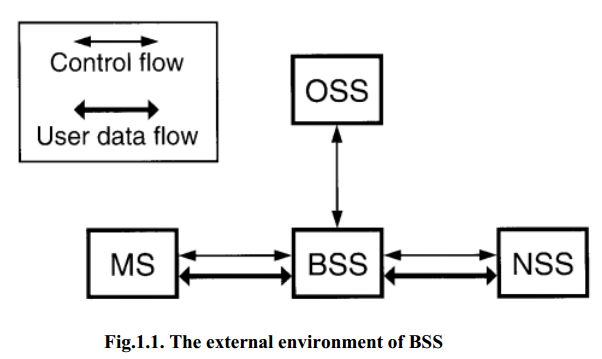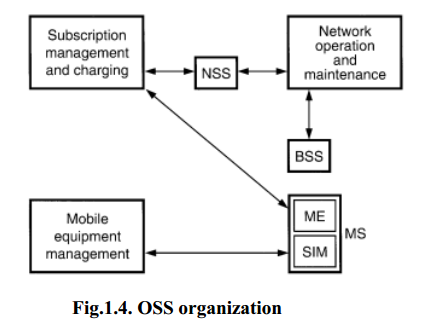Explain in detail about GSM architecture
GLOBAL SYSTEM FOR MOBILE (GSM):
CEPT, a European group, began to develop the Global System for Mobile TDMA system in June 1982.GSM has two objectives: pan-European roaming, which offers compatibility throughout the European continent, and interaction with the integrated service digital network (ISDN), which offers the capability to extend the single-subscriber-line system to a multi service system with various services currently offered only through diverse telecommunications networks. System capacity was not an issue in the initial development of GSM, but due to the unexpected, rapid growth of cellular service, 35 revisions have been made to GSM since the first issued specification. The first commercial GSM system, calledD2, was implemented in Germany in 1992.
 |
| The external environment of BSS |
GSM Architecture :
GSM consists of many subsystems, such as the mobile station (MS), the base station sub system (BSS), the network and switching subsystem (NSS), and the operation subsystem (OSS) in fig.1.1.
1. The Mobile Station: The MS may be a stand-alone piece of equipment for certain services or support the connection of external terminals, such as the interface for a personal computer or fax. The MS includes mobile equipment (ME) and a subscriber identity module (SIM). ME does not need to be personally assigned to one subscriber. The SIM is a subscriber module which stores all the subscriber-related information. When a subscriber’s SIM is inserted into the ME of an MS, that MS belongs to the subscriber, and the call is delivered to that MS. The ME is not associated with a called number—it is linked to the SIM. In this case, any ME can be used by a subscriber when the SIM is inserted in the ME.
2. Base Station Subsystem: The BSS connects to the MS through a radio interface and also connects to the NSS. The BSS consists of a base transceiver station (BTS) located at the antenna site and a base station controller (BSC) that may control several BTSs. The BTS consists of radio transmission and reception equipment similar to the ME in an MS. A transcoder/rate adaption unit (TRAU) carries out encoding and speech decoding and rate adaptation for transmitting data. As a subpart of the BTS, the TRAU may be sited away from the BTS, usually at the MSC. In this case, the low transmission rate of speech code channels allows more compressed transmission between the BTS and the TRAU, which is sited at the MSC.
GSM uses the open system interconnection (OSI). There are three common interfaces based on OSI (Fig. 1.2.): a common radio interface, called air interface, between the MS and BTS, an interface A between the MSC and BSC, and an A-bis interface between the BTS and BSC. With these common interfaces, the system operator can purchase the product of manufacturing company A to interface with the product of manufacturing company B. The difference between interface and protocol is that an interface represents the point of contact between two adjacent entities (equipment or systems) and a protocol provides information flows through the interface. For example, the GSM radio interface is the transit point for information flow pertaining to several protocols.
3. Network and Switching Subsystem: NSS (see Fig.1.3.) in GSM uses an intelligent network (IN). The IN’s attributes will be described later. A signalling NSS includes the main switching functions of GSM. NSS manages the communication between GSM users and other telecommunications users. NSS management consists of:
Mobile service switching center (MSC):
Coordinates call set-up to and from GSM users. An MSC controls several BSCs.
Interworking function (IWF): A gateway for MSC to interface with external networks for communication with users outside GSM, such as packet-switched public data network (PSPDN) or circuit-switched public data network (CSPDN).The role of the IWF depends on the type of user data and the network to which it interfaces.
Home location register (HLR): Consists of a stand-alone computer without switching capabilities, a database which contains subscriber information, and information related to the subscriber’s current location, but not the actual location of the subscriber. A subdivision of HLR is the authentication center (AUC). The AUC manages the security data for subscriber authentication. Another sub-division of HLR is the equipment identity register (EIR) which stores the data of mobile equipment (ME) or ME-related data.
Visitor location register (VLR): Links to one or more MSCs, temporarily storing subscription data currently served by its corresponding MSC, and holding more detailed data than the HLR. For example, the VLR holds more current subscriber location information than the location information at the HLR.
 |
| Functional architecture and principal interfaces |
Gateway MSC (GMSC): In order to set up a requested call, the call is initially routed to a gateway MSC, which finds the correct HLR by knowing the directory number of the GSM subscriber. The GMSC has an interface with the external network for gate waying, and the network also operates the full Signalling System 7 (SS7) signalling between NSS machines.
Signalling transfer point (STP): Is an aspect of the NSS function as a stand-alone node or in the same equipment as the MSC. STP optimizes the cost of the signalling transport among MSC/VLR, GMSC, and HLR.
As mentioned earlier, NSS uses an intelligent network. It separates the central data base (HLR) from the switches (MSC) and uses STP to transport signaling among MSC and HLR.
%20the%20external%20environment;%20(b)%20the%20internal%20structure.PNG) |
| NSS and its environment (a) the external environment; (b) the internal structure |
4. Operation Subsystem: There are three areas of OSS, as shown in Fig.1.4. (1) network operation and maintenance functions, (2) subscription management, including charging and billing, and (3)mobile equipment management. These tasks require interaction between some or all of the infrastructure equipment. OSS is implemented in any existing network.


